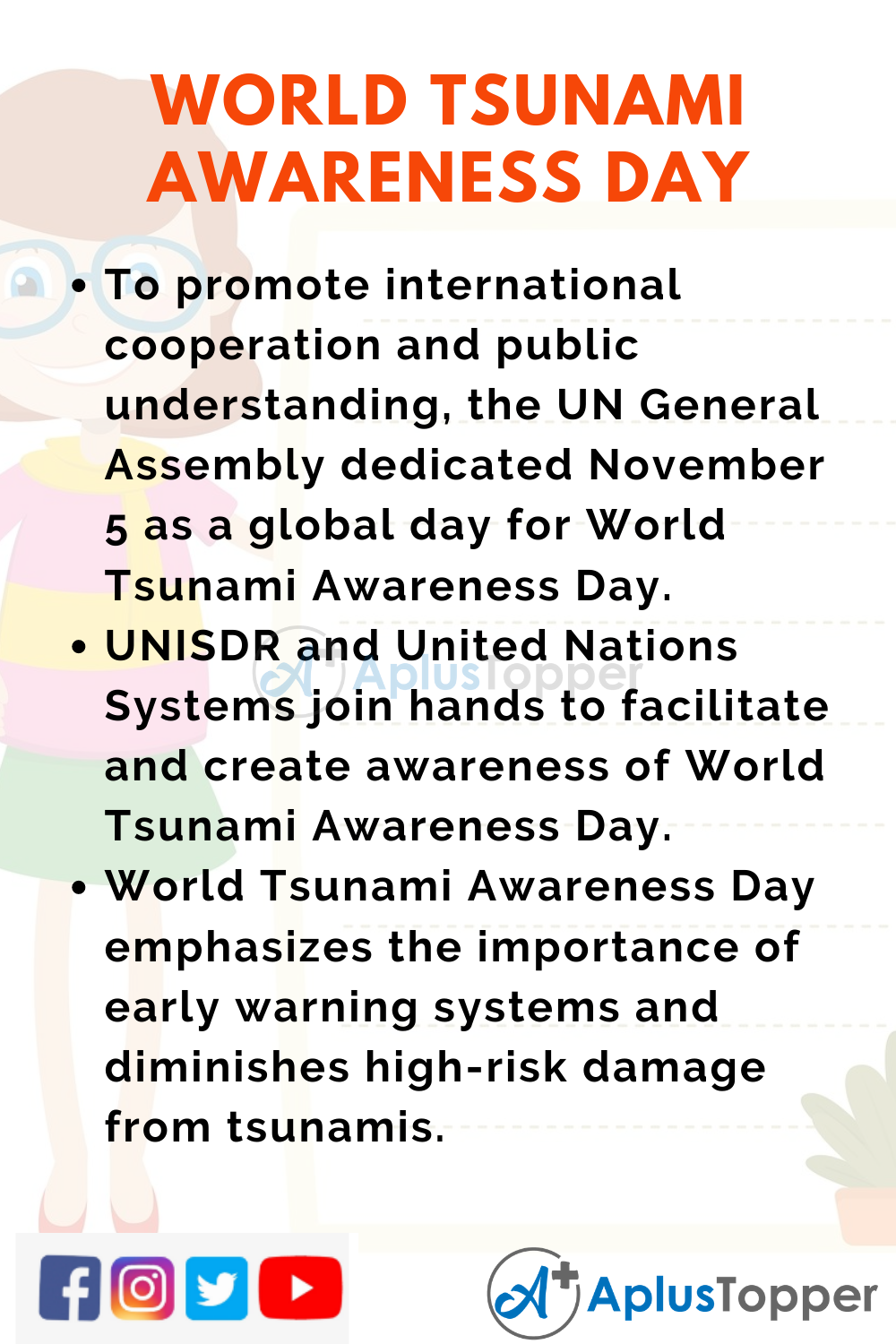10 Lines on World Tsunami Awareness Day: Tsunamis are rare yet deadly natural hazards that havocs, leaving behind a massive wreck. The highest number of deaths in India was during the 2004 Indian Ocean Tsunami that occurred on the dawn of December 26, 2004. Indonesia, Thailand, and India, along with 14 other countries, suffered around 227,000 fatalities and the hardest hits of all time.
UN General Assembly dedicated November 5 as the World Tsunami Awareness Day to take preventive measures. This day is celebrated to take up a public action and build back better after a disaster to reduce future impacts.
The below-mentioned ten lines are provided for kids, children, and students. The below-mentioned lines are aimed to aid in the formulation of debates, assignments, paragraph writings, tests, and essays on the World Tsunami Awareness Day.
You can read more 10 Lines about articles, events, people, sports, technology many more.
Set 1 – 10 Lines on World Tsunami Awareness Day for Kids
Set 1 is helpful for students of Classes 1, 2, 3, 4 and 5.
- The UN General Assembly advocates November 5 to be commemorated as World Tsunami Awareness Day.
- World Tsunami Awareness Day aims to revive the traditional knowledge of tsunamis.
- Ancient Japanese story gave birth to the word ‘Tsunami,’ which means “harbor wave.”
- A tsunami is caused by undersea earthquakes that leads to a series of waves that enforces a sudden disturbance in the sea.
- Most countries experience tsunami waves less than 10 feet high. However, extreme actions exceed 100 feet.
- Tsunamis see no season, weather, or time. Local tsunamis arrive just minutes after an undersea disturbance.
- The deadliest tsunami attack occurred on December 26, 2004, which resulted in the highest number of deaths in that period.
- In India, a workshop is conducted that encourages individuals to build their own Standard Operation Procedures emphasizing actions.
- The workshops also include a table-top exercise that helps people to familiarize responsibilities.
- World Tsunami Awareness Day is a global platform to mitigate high-risk scenarios across the world.

Set 2 – 10 Lines on World Tsunami Awareness Day for School Children
Set 2 is helpful for students of Classes 6, 7 and 8.
- The date of November 5 is globally acknowledged as World Tsunami Awareness Day to honor “Inamura-no-Hi,” a Japanese tsunami story.
- World Tsunami Awareness Day is observed to spread awareness among people worldwide in matters related to the dangers of Tsunami.
- The World Tsunami Awareness Day is dedicated to promoting a global culture that creates awareness of Tsunami and its impact worldwide.
- Tsunami waves rise to a height of 20 to 300 feet and travel at speed depending on the ocean, but the average rate is 800 km/hour.
- To share innovative approaches and raise tsunami awareness to risk reduction, World Tsunami Day focuses on evacuation drills and education,
- Tsunamis have accounted for 10 percent losses in the economies setting back the developmental gains of danger-prone countries.
- To promote World Tsunami Awareness Day, the INCOIS initiates open day for school children, advertises in media, conducts Tsuanmi SOP workshops, and hands out flyers.
- Besides increasing awareness, The INCOIS begins training to create preparedness of participating nations to handle tsunami situations.
- World Tsunami Awareness Day 2019 theme revolved around the promotion of the “Sendai Seven Campaign.”
- Over the past ten decades, 58 tsunami incidents across the world have resulted in the loss of 2.6 lac lives per disaster.
Set 3 – 10 Lines on World Tsunami Awareness Day for Higher Class Students
Set 3 is helpful for students of Classes 9, 10, 11, 12 and Competitive Exams.
- To promote international cooperation and public understanding, the UN General Assembly dedicated November 5 as a global day for World Tsunami Awareness Day.
- UNISDR and United Nations Systems join hands to facilitate and create awareness of World Tsunami Awareness Day.
- World Tsunami Awareness Day emphasizes the importance of early warning systems and diminishes high-risk damage from tsunamis.
- UNESCO conducts platforms that initiate disaster damage reduction, eliminates disruptions, and prevent critical infrastructure.
- Estimates state that around 700 million people reside in the Small Island Developing States and the low-lying coastal regions that remain exposed to extreme sea-level events, including Tsunami.
- On World Tsunami Awareness Day, a global podium is initiated that provides critical education, investment of resilient infrastructure, protection of assets, and early warning systems against the risk of Tsunami in the future.
- Governments across the globe approved the first comprehensive global agreement that led to the development of a 10-year Hyogo Framework for Action, to manage disaster risk reduction.
- World Tsunami Awareness Day is promoted through conferences, thematic events, distribution of materials, and exhibitions.
- UNESCO also focuses on coordinating regional and national tsunami early warning services. It aims to raise global awareness to curb Tsunami disaster.
- The Indian National Centre for Ocean Information Services (INCOIS), located in Hyderabad, provides timely tsunami advisories for India and Indian Ocean rim countries.

FAQ’s on 10 Lines on World Tsunami Awareness Day
Question 1.
When and dedicated World Tsunami Awareness Day?
Answer:
The UN General Assembly advocates November 5 to be commemorated as World Tsunami Awareness Day.
Question 2.
Why was World Tsunami Day advocated?
Answer:
World Tsunami Day was a Japanese brain head initiated in honor of a Japanese tsunami story: “Inamura-no-Hi.”
Question 3.
What is the main focus of World Tsunami Day?
Answer:
World Tsunami Awareness Day focuses on the importance of early warning systems to diminish damage from the often devastating natural hazard.
Question 4.
How is World Tsunami Day promoted?
Answer:
World Tsunami Awareness Day is promoted through conferences, thematic events, distribution of materials, and exhibitions.
